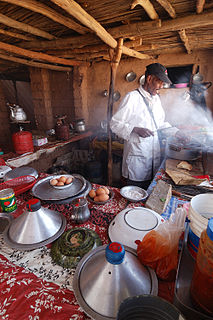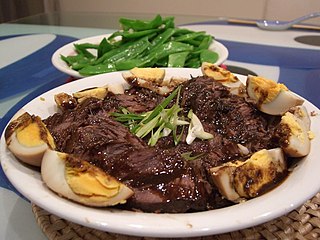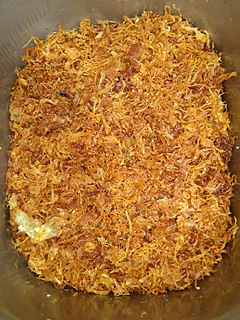
Cooking,cookery, or culinary arts is the art, science, and craft of using heat to prepare food for consumption. Cooking techniques and ingredients vary widely, from grilling food over an open fire to using electric stoves, to baking in various types of ovens, reflecting local conditions.

Braising is a combination-cooking method that uses both wet and dry heats: typically, the food is first browned at a high temperature, then simmered in a covered pot in cooking liquid. It is similar to stewing, but braising is done with less liquid and usually used for larger cuts of meat. Braising of meat is often referred to as pot roasting, though some authors make a distinction between the two methods, based on whether additional liquid is added. Osso buco and coq au vin are well known braised meat dishes, and the technique can be used to prepare fish, tempeh, tofu or fruits and vegetables.

Stir frying is a Chinese cooking technique in which ingredients are fried in a small amount of very hot oil while being stirred or tossed in a wok. The technique originated in China and in recent centuries has spread into other parts of Asia and the West. It is similar to sautéing in Western cooking technique.

A mirepoix is a flavor base made from diced vegetables cooked—usually with butter, oil, or other fat—for a long time on low heat without coloring or browning, as further cooking, often with the addition of tomato purée, creates a darkened brown mixture called pinçage. It is not sautéed or otherwise hard cooked, because the intention is to sweeten the ingredients rather than caramelize them. It is a long-standing cooking technique in French cuisine.

Scrambled eggs is a dish made from eggs stirred, whipped or beaten together while being gently heated, typically with salt, butter, oil and sometimes other ingredients.

Blanquette de veau is a French veal ragout in which neither the veal nor the butter is browned in the cooking process. To refrain from browning meat and fat in this way, is to cook them en blanquette.

Moussaka is an eggplant- or potato-based dish, often including ground meat, which is common in Egypt, the Balkans and the Middle East, with many local and regional variations.

In Italian cuisine, ragù is a meat-based sauce that is commonly served with pasta. An Italian gastronomic society, Accademia Italiana della Cucina, documented several ragù recipes. The recipes' common characteristics are the presence of meat and the fact that all are sauces for pasta. The most typical is ragù alla bolognese. Other types are ragù alla napoletana, and ragù alla barese.

Sofrito, sofregit (Catalan), soffritto, or refogado is a basic preparation in Mediterranean, Latin American, Spanish, Italian and Portuguese cooking. It typically consists of aromatic ingredients cut into small pieces and sautéed or braised in cooking oil.

The following outline is provided as an overview of and topical guide to food preparation:

Peranakan cuisine or Nyonya cuisine comes from the Peranakans, descendants of early Chinese migrants who settled in Penang, Malacca, Singapore and Indonesia, inter-marrying with local Malays. In Baba Malay, a female Peranakan is known as a nonya, and a male Peranakan is known as a baba. The cuisine combines Chinese, Malay, Javanese, South Indian, and other influences.

Fried onions are slices of onions that are either pan fried (sautéed) or deep fried — and consumed as a popular snack food, garnish, or vegetable accompaniment to various recipes.

Afghan cuisine is mainly influenced by Indian, Persian and Mongolian cuisines, due to Afghanistan's central location along Asian trade routes. It is largely based on Afghanistan's main crops, such as wheat, maize, barley, and rice. Accompanying these staple grains are native fruits, vegetables, and dairy products, such as milk, yogurt, whey, pomegranates, grapes, and sweet melons. Its culinary specialties reflect the nation's ethnic and geographic diversity. The national dish of Afghanistan is Kabuli palaw.

Fricassee or fricassée is a stew made with pieces of meat that have been browned in butter that are served in a sauce flavored with the cooking stock. Fricassee is usually made with chicken, veal or rabbit, with variations limited only by what ingredients the cook has at hand.

Bolognese sauce is a meat-based sauce in Italian cuisine, typical of the city of Bologna. It is customarily used to dress tagliatelle al ragù and to prepare lasagne alla bolognese.

Ivorian cuisine is the traditional cuisine of Côte d'Ivoire, or the Ivory Coast, and is based on tubers, grains, pig, chicken, seafood, fish, fresh fruits, vegetables and spices. It is very similar to that of neighboring countries in West Africa. Common staple foods include grains and tubers. Côte d'Ivoire is one of the largest cocoa producers in the world and also produces palm oil and coffee.

Sautéed mushrooms is a flavorful dish prepared by sautéing edible mushrooms. It is served as a side dish, used as an ingredient in dishes such as coq au vin and beef bourguignon, in foods such as duxelles, as a topping for steaks and toast, and also as a garnish.

Afritada is a Philippine dish consisting of chicken, beef, or pork braised in tomato sauce with carrots, potatoes, and red and green bell peppers. It is served on white rice and is a common everyday Filipino meal. It can also be used to cook seafood.


















